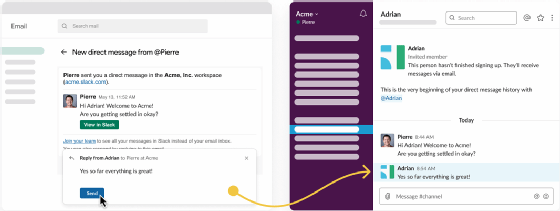
JRB - Fotolia
Slack integration links chats and email
A new Slack integration will give users the ability to receive and reply to Slack chats through email, which remains a cornerstone of enterprise communications.
SAN FRANCISCO -- Slack users will soon be able to receive and reply to Slack messages through email. The integration is a testament to email's continued dominance in business communications, despite pronouncements that team messaging apps would replace it.
IT administrators can now activate a feature that generates an email every time a user receives a Slack message. In the near future, Slack will let users reply to chats through email. The integration will convert an email into a Slack message, indistinguishable from a message sent through the app.
The Slack integration for email underscores how companies often struggle to get users to adopt new communications tools. Some of Slack's largest customers requested the feature as a way to connect active Slack users with colleagues who rarely check the app.
"For the time, we are able to connect people who are doing all their work inside Slack with their teammates who are still wedded to email," said Andy Pflaum, director product management for interoperability at Slack.
The vendor announced the news this week at the Slack Frontiers conference in San Francisco. The ability to receive email is available now, while the reply feature will launch "fairly soon," Pflaum said.
Once dubbed 'email killer,' Slack embraces email
Slack signaled it would step up efforts to integrate with email through its September 2018 acquisition the startup Astro, which made a Slack bot to let users search Slack messages and email inboxes with the same tool.
Earlier this year, Slack released add-ons for Gmail and Microsoft Outlook that let users quickly export email messages to a Slack channel. The feature avoids reply-all email chains by bringing the email and its into Slack, where team members can discuss it.
The Slack integration for email unveiled this week does not require installation an add-on. IT administrators can activate the feature for any given workspace, and users can opt out. It works with any standards-based email system.
"Slack initially seemed intent on replacing email, but that changed a couple years ago," said Raúl Castañón-Martinez, analyst at 451 Research. "Slack is now taking steps to incorporate email, rather than replace it, as part its overall approach to business communications."
The Slack integration for email launched in 2015, with a bot that would automatically bring certain email messages -- every email sent to a company's support address, for example -- into Slack. The new features significantly expand Slack's ties to email by making email integrations interactive.
The new email bridge will be unique among team collaboration apps, helping Slack differentiate from competitors Microsoft Teams and Cisco Webex Teams. But Slack is not alone in pursuing closer links between messaging and email.
Workplace by Facebook, for instance, plans to add technology from Redkix to its collaboration and intranet app. Acquired by Facebook last year, Redkix is a team messaging app that converts chats to email when corresponding with external collaborators.

Slack enhances email calendar bots
Slack this week previewed an AI feature meant to simplify the process of scheduling meetings. The feature will detect when a group of users is considering a meeting and automatically generates a form to create a calendar event.
For example, if a user messaged, "We should meet on this tomorrow afternoon," the tool would create a calendar invite for the Slack users in that channel for some time in the afternoon the following day.
The feature is an expansion of Slack's bots for Gmail and Microsoft Outlook. Slack recently updated those bots, so they send automatic meeting reminders to Slack, and users can sync Slack statuses, which indicate whether a user is available to chat, with the events on their email calendar.
The new AI feature will be available later this year, Slack said.






